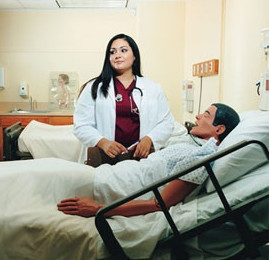There are two ways to go about obtaining a license. Some people prefer to wait until they have an assignment before applying for the state license. In this case, most agencies have a licensing team that will assist you in the process. You will most likely have to complete a standard form with your personal information, and they will use that data to complete the license applications for you.
Others will apply for a license in a state they are committed to working in, even before having an actual assignment. In this instance, they are more likely to apply on their own. Sometimes agencies will allow you to apply for a license proactively (before confirming an assignment), and in this case they will assist with the application.
It’s great when a state’s application is online and everything can be done electronically. For example, my application with Texas was all electronic and therefore the process was quick. On the other hand, some states only have paper applications in which you have to submit via mail. My application for the Washington state license took a little longer than expected due to this process. Apparently it can take about 2 weeks for mail to be received from the east coast to the west coast.
In each state you will need two licenses: RN and ARNP. Some states may even require an additional application for prescriptive authority. Typically this is just an extra fee or additional pharmacological CEUs. Some states will allow you to submit both the RN and ARNP application at the same time, while other states will only allow you to submit the ARNP application once you have been issued a temporary or permanent RN license.
- For the RN license, you will need to submit the following (depending on the state):
-Application and fee
-Nursys verification (tells the new state that you have a license through examination/schooling from your current state)
-Fingerprints/Background check and fee
-RN transcripts (depending on the state)
- For the ARNP license, you will need to submit the following (depending on the state):
-Application and fee
-Verification of education form (depending on state)
-Graduate school transcripts
-Certification verification by ANCC/AANP
-Additional prescriptive fee or CEUs (depending on state)
The point is to notice that there are a lot of requirements and it can easily be overwhelming. I find it best to just read the application thoroughly and contact the board of nursing if I need to clarify anything. I keep a checklist for each state that I am applying to, to make sure I have everything covered. Keep in mind that you only need one set of fingerprints/background check per RN & ARNP applications.
Some states request miscellaneous things. For example: California requests passport photos for both applications; Washington requires a proof of current employment as an ARNP (can be a note from your employer or a pay stub), Texas requires you to take and pass a nursing jurisprudence exam etc.
- Benefits of applying for licenses on your own:
-You are not restricted to a specific agency (but can be reimbursed after selecting agency/assignment)
-Work is less redundant – you are not filling in a separate form for the agency, nor answering questions about your application for the agency representative
-Even if the agency applied for you, you would still have to do a lot of the leg work yourself (fingerprints, requesting transcripts etc.)
- Benefits of applying for licenses through your agency:
-Quick turnover (they overnight all mail)
-There is someone checking up on the status of your application almost daily
-Less stress for you if you are not organized
-No upfront costs
Make sure to keep receipts of everything if you expect to be reimbursed. For applications sent via mail, I usually ask them to email me a receipt. Initially applying for a license appears to be a lot of work, but then you realize it’s nothing you haven’t done before.

